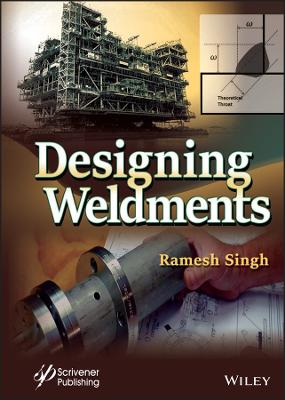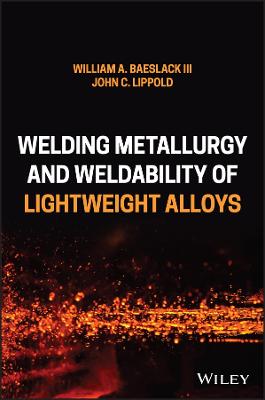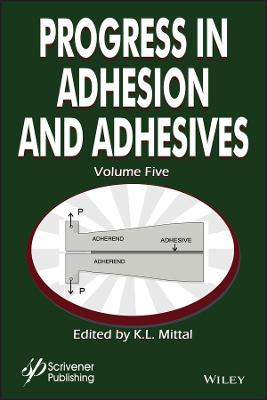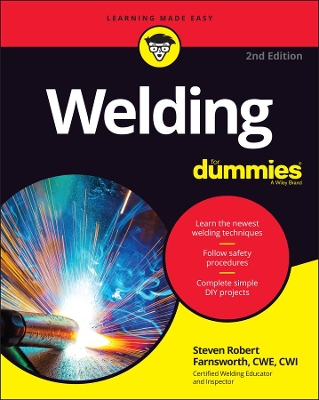Designing Weldments
 -15%
portes grátis
-15%
portes grátis
Designing Weldments
Singh, Ramesh
John Wiley & Sons Inc
08/2022
240
Dura
Inglês
9781119865155
15 a 20 dias
666
Descrição não disponível.
List of Figures xi
List of Tables xv
Foreword xvii
Preface xix
1 Properties and Strength of Material 1
1.1 Introduction 1
2 Properties of Metals 3
2.1 Material Properties 3
2.1.1 Structure Insensitive Properties 4
2.1.2 Structure Sensitive Properties 4
2.1.3 Mechanical Properties 5
2.1.3.1 Modulus of Elasticity 5
2.1.3.2 Tensile Strength 6
2.1.3.3 Yield Strength 7
2.1.3.4 Fatigue Strength 7
2.1.3.5 Ductility 8
2.1.3.6 Elastic Limit 9
2.1.3.7 Impact Strength 10
2.1.3.8 Energy Absorption in Impact Testing 10
2.1.3.9 Transition Temperature for Energy Absorption 11
2.1.3.10 Transition Temperature for Lateral Expansion 11
2.1.3.11 Drop-Weight Tear Test (DWTT) 11
2.1.3.12 Fracture Toughness 11
2.1.4 Low Temperature Properties 14
2.1.4.1 Metal Strength at Low Temperature 16
2.1.5 Elevated Temperature Properties 16
2.1.6 Physical Properties 17
2.1.6.1 Thermal Conductivity 17
2.1.6.2 Coefficient of Thermal Expansion 17
2.1.6.3 Melting Point 17
2.1.7 Electrical Conductivity 18
2.1.8 Corrosion Properties 18
3 Design: Load Conditions 19
3.1 Design of Welds 19
3.2 Design by Calculations 20
3.2.1 Different Types of Loading 21
3.2.2 Tension 23
3.2.3 Compression 24
3.2.4 Bending 25
3.2.5 Shear 28
3.2.6 Torsion 29
3.2.7 Flat Sections 31
3.2.8 Round Cross Sectionals 32
3.2.9 Transfer of Forces 33
4 Design of Welds and Weldments 35
4.1 Introduction 35
4.1.1 Structural Types that Affect Weld Design 38
4.2 Full Penetration Welds 38
4.3 Partial Penetration Welds 39
4.4 Groove Welds 39
4.4.1 Definitions of Terms Applicable to Groove Welds 39
4.4.1.1 Effective Length 40
4.4.1.2 Effective Size of CJP Groove Welds 40
4.4.1.3 Effective Weld Size (Flare Groove) 40
4.4.1.4 Effective Area of Groove Welds 40
4.5 Weld Grooves 42
4.5.1 Square Groove Welds 42
4.5.2 Single Bevel Groove Welds 43
4.5.3 Double Bevel Groove Weld 43
4.5.4 Single-V-Groove Weld 43
4.5.5 Double-V-Groove Welds 44
4.5.6 Single or Double-J-Groove Weld 44
4.5.7 Single or Double-U-Groove Weld 44
4.6 Fillet Welds 44
4.6.1 Definitions Applicable to Fillet Welds 45
4.6.1.1 Effective Length (Straight) 45
4.6.1.2 Effective Length (Curved) 45
4.6.1.3 Minimum Length 45
4.6.1.4 Intermittent Fillet Welds (Minimum Length) 45
4.6.1.5 Maximum Effective Length 45
4.6.1.6 Calculation of Effective Throat 45
4.6.1.7 Reinforcing Fillet Welds 46
4.6.1.8 Maximum Weld Size in Lap Joints 46
4.6.1.9 Effective Area of Fillet Welds 46
4.7 About Fillet Weld 46
4.7.1 Filet Weld Defined and Explained 47
4.7.1.1 Single Fillet Welds 52
4.7.1.2 Double Fillet Welds 52
4.7.1.3 Combined Groove and Fillet Welds 52
4.8 Weld Design and Loading 54
4.8.1 Common Conditions to Consider When Designing Welded Connections 55
4.8.2 Marking the Fabrication and Construction Drawings 55
4.8.3 Effective Areas 57
4.8.4 Effective Area of Groove Welds 57
4.9 Sizing Fillet Welds 59
4.9.1 Effective Length of Straight Fillet Welds 59
4.9.2 The Determination of Effective Throat of a Fillet Weld 59
4.9.2.1 Fillet Welds Joining Perpendicular Members 59
4.9.2.2 Fillet Weld in Acute Angle 60
4.9.2.3 Fillet Welds That Make Angle Between 60 o and 80 o 60
4.9.2.4 Fillet Welds That Make Acute Angle Between 60 o and 30 o 61
4.9.2.5 Reinforcing Fillet Welds 61
4.9.3 Fillet Welds - Minimum Size 61
4.9.4 Maximum Weld Size in Lap Joints 62
4.9.5 Skewed T-Joints 63
4.9.5.1 T-Joint Welds in Acute Angles Between 80 degrees and 60 degrees and in Obtuse Angles Greater Than 100 degrees 63
4.9.5.2 T-Joint Welds in Angles Between 60 degrees and 30 degrees 63
4.9.5.3 T-Joint Welds in Angles Less than 30 degrees 63
4.9.5.4 Effective Length of Skewed T-Joints 64
4.9.5.5 Effective Throat of Skewed T-Joints 64
4.9.5.6 Effective Area of Skewed T-Joints 64
4.10 Fillet Welds in Holes and Slots 64
4.10.1 Slot Ends 64
4.10.2 Effective Length of Fillet Welds in Holes or Slots 64
4.10.3 Effective Area of Fillet Welds in Holes or Slots 64
4.10.4 Diameter and Width Limitations 64
4.10.5 Slot Length and Shape 65
4.10.6 Effective Area of Plug and Slot Welds 65
4.11 Designing Calculations for Skewed Fillet Weld 65
4.12 Treating Weld as a Line 66
4.12.1 Calculation Approach 67
4.12.2 Finding the Size of the Weld 67
4.12.3 Calculated Stresses 73
4.12.4 Stress in Fillet Welds 73
4.12.5 Joint Configuration and Details 74
4.12.6 Compression Member Connections and Splices 75
4.12.7 Where There is an Issue of Through-Thickness Loading on the Base Plate 75
4.12.8 Determining the Capacity of Combinations of Welds 75
4.12.9 Corner and T-Joint Surface Contouring 75
4.12.10 Weld Access Holes 75
4.12.11 Welds with Rivets or Bolts 76
4.12.12 Joint Configuration and Details 76
4.12.12.1 Groove Welds - Transitions in Thicknesses and Widths 76
4.12.12.2 Partial Length CJP Groove Weld Prohibition 76
4.12.12.3 Flare Welds, Flare Groove and Intermittent PJP Groove Welds 76
4.12.12.4 Joint Configuration and Details 77
4.12.12.5 Termination of Fillet Welds 77
4.12.12.6 Fillet Welds in Holes and Slots 78
4.13 Design of Tubular Connections 80
4.13.1 Weld Joint Design 82
4.13.2 Uneven Distribution of Load 88
4.13.3 Collapse 91
4.13.4 Lamellar Tear and Lamination 91
4.13.5 Fatigue 92
4.14 Design for Cyclic Loading 93
4.14.1 Improving Fatigue Performance of Welds, and Evaluation of S-N Curves for Design 105
4.14.1.1 Typical Weld Flushing Plan 107
4.15 Aluminum 107
4.15.1 Aluminum Alloys and Their Characteristics 108
4.15.1.1 Aluminum Alloys Series 1xxx 108
4.15.1.2 Aluminum Alloy Series 2xxx 109
4.15.1.3 Aluminum Alloy Series 3xxx 109
4.15.1.4 Aluminum Alloy Series 4xxx 109
4.15.1.5 Aluminum Alloy Series 5xxx 109
4.15.1.6 Aluminum Alloy Series 6xxx 110
4.15.1.7 Aluminum Alloy Series 7xxx 110
4.15.2 The Aluminum Alloy Temper and Designation System 110
4.15.3 Wrought Alloy Designation System 111
4.15.4 Cast Alloy Designation 111
4.15.5 The Aluminum Temper Designation System 112
4.16 Welding Aluminum 114
4.16.1 Aluminum Welding Electrodes 115
4.16.2 Electrical Parameters 115
4.17 Design for Welding Aluminum 116
4.17.1 Effect of Welding on the Strength of Aluminum and its Alloys 117
4.17.2 Effect of Service Temperature 119
4.17.3 Type of Weld Joints for Aluminum Welding 120
4.17.3.1 Butt Joints 120
4.17.4 Lap Joint for Aluminum Welding 121
4.17.5 Use of T-Joints in Aluminum Welding 121
4.18 Distribution of Stress in Aluminum Weld Design 122
4.18.1 Shear Strength of Aluminum Fillet Welds 123
4.18.2 Fatigue Strength in Aluminum Welds 123
4.19 Heat and Distortion Control 124
4.19.1 Angular Distortion 125
4.19.2 Longitudinal Distortions 126
5 Introduction to Welding Processes 131
5.1 Introduction 131
5.2 Shielded Metal Arc Welding (SMAW) 134
5.3 Gas Tungsten Arc Welding 139
5.4 Gas Metal Arc Welding 142
5.5 Flux Cored Arc Welding (FCAW) 145
5.6 Submerged Arc Welding (SAW) 145
5.7 Electroslag Welding (ESW) 146
5.8 Plasma Arc Welding 146
5.9 Stud Welding 146
5.10 Oxyfuel Gas Welding 147
5.11 Hyperbaric Welding 152
5.12 Application of Welding Processes 153
6 Welding Symbols 155
6.1 Introduction 155
6.2 Common Weld Symbols and Their Meanings 156
6.2.1 The Basic Structure of Welding Symbol 156
6.2.2 Types of Welds and Their Symbols 157
6.3 Fillet Welds 158
6.3.1 The Length of the Fillet Weld 159
6.4 Groove Welds 160
6.4.1 Square Groove Welds 161
6.4.2 V-Groove Welds 161
6.5 Bevel Groove Welds 162
6.5.1 U-Groove Welds 163
6.5.2 J-Groove Welds 163
6.5.3 Flare-V Groove Welds 164
6.5.4 Flare Bevel Groove Weld 164
6.6 Plug and Slot Welds 166
7 Structural Design and Welding Specifications, and Other Useful Information 169
7.1 Introduction 169
7.2 Structural Welding Codes 169
7.3 Useful Engineering Information 174
Index 201
List of Tables xv
Foreword xvii
Preface xix
1 Properties and Strength of Material 1
1.1 Introduction 1
2 Properties of Metals 3
2.1 Material Properties 3
2.1.1 Structure Insensitive Properties 4
2.1.2 Structure Sensitive Properties 4
2.1.3 Mechanical Properties 5
2.1.3.1 Modulus of Elasticity 5
2.1.3.2 Tensile Strength 6
2.1.3.3 Yield Strength 7
2.1.3.4 Fatigue Strength 7
2.1.3.5 Ductility 8
2.1.3.6 Elastic Limit 9
2.1.3.7 Impact Strength 10
2.1.3.8 Energy Absorption in Impact Testing 10
2.1.3.9 Transition Temperature for Energy Absorption 11
2.1.3.10 Transition Temperature for Lateral Expansion 11
2.1.3.11 Drop-Weight Tear Test (DWTT) 11
2.1.3.12 Fracture Toughness 11
2.1.4 Low Temperature Properties 14
2.1.4.1 Metal Strength at Low Temperature 16
2.1.5 Elevated Temperature Properties 16
2.1.6 Physical Properties 17
2.1.6.1 Thermal Conductivity 17
2.1.6.2 Coefficient of Thermal Expansion 17
2.1.6.3 Melting Point 17
2.1.7 Electrical Conductivity 18
2.1.8 Corrosion Properties 18
3 Design: Load Conditions 19
3.1 Design of Welds 19
3.2 Design by Calculations 20
3.2.1 Different Types of Loading 21
3.2.2 Tension 23
3.2.3 Compression 24
3.2.4 Bending 25
3.2.5 Shear 28
3.2.6 Torsion 29
3.2.7 Flat Sections 31
3.2.8 Round Cross Sectionals 32
3.2.9 Transfer of Forces 33
4 Design of Welds and Weldments 35
4.1 Introduction 35
4.1.1 Structural Types that Affect Weld Design 38
4.2 Full Penetration Welds 38
4.3 Partial Penetration Welds 39
4.4 Groove Welds 39
4.4.1 Definitions of Terms Applicable to Groove Welds 39
4.4.1.1 Effective Length 40
4.4.1.2 Effective Size of CJP Groove Welds 40
4.4.1.3 Effective Weld Size (Flare Groove) 40
4.4.1.4 Effective Area of Groove Welds 40
4.5 Weld Grooves 42
4.5.1 Square Groove Welds 42
4.5.2 Single Bevel Groove Welds 43
4.5.3 Double Bevel Groove Weld 43
4.5.4 Single-V-Groove Weld 43
4.5.5 Double-V-Groove Welds 44
4.5.6 Single or Double-J-Groove Weld 44
4.5.7 Single or Double-U-Groove Weld 44
4.6 Fillet Welds 44
4.6.1 Definitions Applicable to Fillet Welds 45
4.6.1.1 Effective Length (Straight) 45
4.6.1.2 Effective Length (Curved) 45
4.6.1.3 Minimum Length 45
4.6.1.4 Intermittent Fillet Welds (Minimum Length) 45
4.6.1.5 Maximum Effective Length 45
4.6.1.6 Calculation of Effective Throat 45
4.6.1.7 Reinforcing Fillet Welds 46
4.6.1.8 Maximum Weld Size in Lap Joints 46
4.6.1.9 Effective Area of Fillet Welds 46
4.7 About Fillet Weld 46
4.7.1 Filet Weld Defined and Explained 47
4.7.1.1 Single Fillet Welds 52
4.7.1.2 Double Fillet Welds 52
4.7.1.3 Combined Groove and Fillet Welds 52
4.8 Weld Design and Loading 54
4.8.1 Common Conditions to Consider When Designing Welded Connections 55
4.8.2 Marking the Fabrication and Construction Drawings 55
4.8.3 Effective Areas 57
4.8.4 Effective Area of Groove Welds 57
4.9 Sizing Fillet Welds 59
4.9.1 Effective Length of Straight Fillet Welds 59
4.9.2 The Determination of Effective Throat of a Fillet Weld 59
4.9.2.1 Fillet Welds Joining Perpendicular Members 59
4.9.2.2 Fillet Weld in Acute Angle 60
4.9.2.3 Fillet Welds That Make Angle Between 60 o and 80 o 60
4.9.2.4 Fillet Welds That Make Acute Angle Between 60 o and 30 o 61
4.9.2.5 Reinforcing Fillet Welds 61
4.9.3 Fillet Welds - Minimum Size 61
4.9.4 Maximum Weld Size in Lap Joints 62
4.9.5 Skewed T-Joints 63
4.9.5.1 T-Joint Welds in Acute Angles Between 80 degrees and 60 degrees and in Obtuse Angles Greater Than 100 degrees 63
4.9.5.2 T-Joint Welds in Angles Between 60 degrees and 30 degrees 63
4.9.5.3 T-Joint Welds in Angles Less than 30 degrees 63
4.9.5.4 Effective Length of Skewed T-Joints 64
4.9.5.5 Effective Throat of Skewed T-Joints 64
4.9.5.6 Effective Area of Skewed T-Joints 64
4.10 Fillet Welds in Holes and Slots 64
4.10.1 Slot Ends 64
4.10.2 Effective Length of Fillet Welds in Holes or Slots 64
4.10.3 Effective Area of Fillet Welds in Holes or Slots 64
4.10.4 Diameter and Width Limitations 64
4.10.5 Slot Length and Shape 65
4.10.6 Effective Area of Plug and Slot Welds 65
4.11 Designing Calculations for Skewed Fillet Weld 65
4.12 Treating Weld as a Line 66
4.12.1 Calculation Approach 67
4.12.2 Finding the Size of the Weld 67
4.12.3 Calculated Stresses 73
4.12.4 Stress in Fillet Welds 73
4.12.5 Joint Configuration and Details 74
4.12.6 Compression Member Connections and Splices 75
4.12.7 Where There is an Issue of Through-Thickness Loading on the Base Plate 75
4.12.8 Determining the Capacity of Combinations of Welds 75
4.12.9 Corner and T-Joint Surface Contouring 75
4.12.10 Weld Access Holes 75
4.12.11 Welds with Rivets or Bolts 76
4.12.12 Joint Configuration and Details 76
4.12.12.1 Groove Welds - Transitions in Thicknesses and Widths 76
4.12.12.2 Partial Length CJP Groove Weld Prohibition 76
4.12.12.3 Flare Welds, Flare Groove and Intermittent PJP Groove Welds 76
4.12.12.4 Joint Configuration and Details 77
4.12.12.5 Termination of Fillet Welds 77
4.12.12.6 Fillet Welds in Holes and Slots 78
4.13 Design of Tubular Connections 80
4.13.1 Weld Joint Design 82
4.13.2 Uneven Distribution of Load 88
4.13.3 Collapse 91
4.13.4 Lamellar Tear and Lamination 91
4.13.5 Fatigue 92
4.14 Design for Cyclic Loading 93
4.14.1 Improving Fatigue Performance of Welds, and Evaluation of S-N Curves for Design 105
4.14.1.1 Typical Weld Flushing Plan 107
4.15 Aluminum 107
4.15.1 Aluminum Alloys and Their Characteristics 108
4.15.1.1 Aluminum Alloys Series 1xxx 108
4.15.1.2 Aluminum Alloy Series 2xxx 109
4.15.1.3 Aluminum Alloy Series 3xxx 109
4.15.1.4 Aluminum Alloy Series 4xxx 109
4.15.1.5 Aluminum Alloy Series 5xxx 109
4.15.1.6 Aluminum Alloy Series 6xxx 110
4.15.1.7 Aluminum Alloy Series 7xxx 110
4.15.2 The Aluminum Alloy Temper and Designation System 110
4.15.3 Wrought Alloy Designation System 111
4.15.4 Cast Alloy Designation 111
4.15.5 The Aluminum Temper Designation System 112
4.16 Welding Aluminum 114
4.16.1 Aluminum Welding Electrodes 115
4.16.2 Electrical Parameters 115
4.17 Design for Welding Aluminum 116
4.17.1 Effect of Welding on the Strength of Aluminum and its Alloys 117
4.17.2 Effect of Service Temperature 119
4.17.3 Type of Weld Joints for Aluminum Welding 120
4.17.3.1 Butt Joints 120
4.17.4 Lap Joint for Aluminum Welding 121
4.17.5 Use of T-Joints in Aluminum Welding 121
4.18 Distribution of Stress in Aluminum Weld Design 122
4.18.1 Shear Strength of Aluminum Fillet Welds 123
4.18.2 Fatigue Strength in Aluminum Welds 123
4.19 Heat and Distortion Control 124
4.19.1 Angular Distortion 125
4.19.2 Longitudinal Distortions 126
5 Introduction to Welding Processes 131
5.1 Introduction 131
5.2 Shielded Metal Arc Welding (SMAW) 134
5.3 Gas Tungsten Arc Welding 139
5.4 Gas Metal Arc Welding 142
5.5 Flux Cored Arc Welding (FCAW) 145
5.6 Submerged Arc Welding (SAW) 145
5.7 Electroslag Welding (ESW) 146
5.8 Plasma Arc Welding 146
5.9 Stud Welding 146
5.10 Oxyfuel Gas Welding 147
5.11 Hyperbaric Welding 152
5.12 Application of Welding Processes 153
6 Welding Symbols 155
6.1 Introduction 155
6.2 Common Weld Symbols and Their Meanings 156
6.2.1 The Basic Structure of Welding Symbol 156
6.2.2 Types of Welds and Their Symbols 157
6.3 Fillet Welds 158
6.3.1 The Length of the Fillet Weld 159
6.4 Groove Welds 160
6.4.1 Square Groove Welds 161
6.4.2 V-Groove Welds 161
6.5 Bevel Groove Welds 162
6.5.1 U-Groove Welds 163
6.5.2 J-Groove Welds 163
6.5.3 Flare-V Groove Welds 164
6.5.4 Flare Bevel Groove Weld 164
6.6 Plug and Slot Welds 166
7 Structural Design and Welding Specifications, and Other Useful Information 169
7.1 Introduction 169
7.2 Structural Welding Codes 169
7.3 Useful Engineering Information 174
Index 201
Este título pertence ao(s) assunto(s) indicados(s). Para ver outros títulos clique no assunto desejado.
<p>Groove welds; Fillet welds; Skewed fillet welds; Slot and hole welds; Complete Joint Penetration joints; Partial Joint Penetration joints; Acute and Obtuse angle welds; Dihedral angles; Z-loss; Static loading; Cyclic loading; strength and size of weld; Structure insensitive properties; Structure sensitive properties; Tensile Strength; Yield Strength; Fatigue Strength; Modulus of Elasticity Impact tests; Elastic Limit; Ductility; Strength of Welded Joints; Material's Tensile Strength; Heat Treatment; Crack Propagation Rates; Transition Temperature for Lateral Expansion; Fracture Toughness; Metal Strength at Low temperature; Elevated Temperature Properties; Physical Properties; Thermal Conductivity; Coefficient of Thermal Expansion; Melting Point; Electrical Conductivity; Corrosion Properties; Process Fundamentals; Square Groove Welds; Single Bevel Groove Welds; Double Bevel Groove Weld; Single-V-Groove Weld; Double-V-Groove Welds; Single or Double-J-groove weld; Single or Double-U-groove weld; Fillet welds; Single Fillet Welds; Double Fillet Welds; Combined Groove and Fillet welds</p>
List of Figures xi
List of Tables xv
Foreword xvii
Preface xix
1 Properties and Strength of Material 1
1.1 Introduction 1
2 Properties of Metals 3
2.1 Material Properties 3
2.1.1 Structure Insensitive Properties 4
2.1.2 Structure Sensitive Properties 4
2.1.3 Mechanical Properties 5
2.1.3.1 Modulus of Elasticity 5
2.1.3.2 Tensile Strength 6
2.1.3.3 Yield Strength 7
2.1.3.4 Fatigue Strength 7
2.1.3.5 Ductility 8
2.1.3.6 Elastic Limit 9
2.1.3.7 Impact Strength 10
2.1.3.8 Energy Absorption in Impact Testing 10
2.1.3.9 Transition Temperature for Energy Absorption 11
2.1.3.10 Transition Temperature for Lateral Expansion 11
2.1.3.11 Drop-Weight Tear Test (DWTT) 11
2.1.3.12 Fracture Toughness 11
2.1.4 Low Temperature Properties 14
2.1.4.1 Metal Strength at Low Temperature 16
2.1.5 Elevated Temperature Properties 16
2.1.6 Physical Properties 17
2.1.6.1 Thermal Conductivity 17
2.1.6.2 Coefficient of Thermal Expansion 17
2.1.6.3 Melting Point 17
2.1.7 Electrical Conductivity 18
2.1.8 Corrosion Properties 18
3 Design: Load Conditions 19
3.1 Design of Welds 19
3.2 Design by Calculations 20
3.2.1 Different Types of Loading 21
3.2.2 Tension 23
3.2.3 Compression 24
3.2.4 Bending 25
3.2.5 Shear 28
3.2.6 Torsion 29
3.2.7 Flat Sections 31
3.2.8 Round Cross Sectionals 32
3.2.9 Transfer of Forces 33
4 Design of Welds and Weldments 35
4.1 Introduction 35
4.1.1 Structural Types that Affect Weld Design 38
4.2 Full Penetration Welds 38
4.3 Partial Penetration Welds 39
4.4 Groove Welds 39
4.4.1 Definitions of Terms Applicable to Groove Welds 39
4.4.1.1 Effective Length 40
4.4.1.2 Effective Size of CJP Groove Welds 40
4.4.1.3 Effective Weld Size (Flare Groove) 40
4.4.1.4 Effective Area of Groove Welds 40
4.5 Weld Grooves 42
4.5.1 Square Groove Welds 42
4.5.2 Single Bevel Groove Welds 43
4.5.3 Double Bevel Groove Weld 43
4.5.4 Single-V-Groove Weld 43
4.5.5 Double-V-Groove Welds 44
4.5.6 Single or Double-J-Groove Weld 44
4.5.7 Single or Double-U-Groove Weld 44
4.6 Fillet Welds 44
4.6.1 Definitions Applicable to Fillet Welds 45
4.6.1.1 Effective Length (Straight) 45
4.6.1.2 Effective Length (Curved) 45
4.6.1.3 Minimum Length 45
4.6.1.4 Intermittent Fillet Welds (Minimum Length) 45
4.6.1.5 Maximum Effective Length 45
4.6.1.6 Calculation of Effective Throat 45
4.6.1.7 Reinforcing Fillet Welds 46
4.6.1.8 Maximum Weld Size in Lap Joints 46
4.6.1.9 Effective Area of Fillet Welds 46
4.7 About Fillet Weld 46
4.7.1 Filet Weld Defined and Explained 47
4.7.1.1 Single Fillet Welds 52
4.7.1.2 Double Fillet Welds 52
4.7.1.3 Combined Groove and Fillet Welds 52
4.8 Weld Design and Loading 54
4.8.1 Common Conditions to Consider When Designing Welded Connections 55
4.8.2 Marking the Fabrication and Construction Drawings 55
4.8.3 Effective Areas 57
4.8.4 Effective Area of Groove Welds 57
4.9 Sizing Fillet Welds 59
4.9.1 Effective Length of Straight Fillet Welds 59
4.9.2 The Determination of Effective Throat of a Fillet Weld 59
4.9.2.1 Fillet Welds Joining Perpendicular Members 59
4.9.2.2 Fillet Weld in Acute Angle 60
4.9.2.3 Fillet Welds That Make Angle Between 60 o and 80 o 60
4.9.2.4 Fillet Welds That Make Acute Angle Between 60 o and 30 o 61
4.9.2.5 Reinforcing Fillet Welds 61
4.9.3 Fillet Welds - Minimum Size 61
4.9.4 Maximum Weld Size in Lap Joints 62
4.9.5 Skewed T-Joints 63
4.9.5.1 T-Joint Welds in Acute Angles Between 80 degrees and 60 degrees and in Obtuse Angles Greater Than 100 degrees 63
4.9.5.2 T-Joint Welds in Angles Between 60 degrees and 30 degrees 63
4.9.5.3 T-Joint Welds in Angles Less than 30 degrees 63
4.9.5.4 Effective Length of Skewed T-Joints 64
4.9.5.5 Effective Throat of Skewed T-Joints 64
4.9.5.6 Effective Area of Skewed T-Joints 64
4.10 Fillet Welds in Holes and Slots 64
4.10.1 Slot Ends 64
4.10.2 Effective Length of Fillet Welds in Holes or Slots 64
4.10.3 Effective Area of Fillet Welds in Holes or Slots 64
4.10.4 Diameter and Width Limitations 64
4.10.5 Slot Length and Shape 65
4.10.6 Effective Area of Plug and Slot Welds 65
4.11 Designing Calculations for Skewed Fillet Weld 65
4.12 Treating Weld as a Line 66
4.12.1 Calculation Approach 67
4.12.2 Finding the Size of the Weld 67
4.12.3 Calculated Stresses 73
4.12.4 Stress in Fillet Welds 73
4.12.5 Joint Configuration and Details 74
4.12.6 Compression Member Connections and Splices 75
4.12.7 Where There is an Issue of Through-Thickness Loading on the Base Plate 75
4.12.8 Determining the Capacity of Combinations of Welds 75
4.12.9 Corner and T-Joint Surface Contouring 75
4.12.10 Weld Access Holes 75
4.12.11 Welds with Rivets or Bolts 76
4.12.12 Joint Configuration and Details 76
4.12.12.1 Groove Welds - Transitions in Thicknesses and Widths 76
4.12.12.2 Partial Length CJP Groove Weld Prohibition 76
4.12.12.3 Flare Welds, Flare Groove and Intermittent PJP Groove Welds 76
4.12.12.4 Joint Configuration and Details 77
4.12.12.5 Termination of Fillet Welds 77
4.12.12.6 Fillet Welds in Holes and Slots 78
4.13 Design of Tubular Connections 80
4.13.1 Weld Joint Design 82
4.13.2 Uneven Distribution of Load 88
4.13.3 Collapse 91
4.13.4 Lamellar Tear and Lamination 91
4.13.5 Fatigue 92
4.14 Design for Cyclic Loading 93
4.14.1 Improving Fatigue Performance of Welds, and Evaluation of S-N Curves for Design 105
4.14.1.1 Typical Weld Flushing Plan 107
4.15 Aluminum 107
4.15.1 Aluminum Alloys and Their Characteristics 108
4.15.1.1 Aluminum Alloys Series 1xxx 108
4.15.1.2 Aluminum Alloy Series 2xxx 109
4.15.1.3 Aluminum Alloy Series 3xxx 109
4.15.1.4 Aluminum Alloy Series 4xxx 109
4.15.1.5 Aluminum Alloy Series 5xxx 109
4.15.1.6 Aluminum Alloy Series 6xxx 110
4.15.1.7 Aluminum Alloy Series 7xxx 110
4.15.2 The Aluminum Alloy Temper and Designation System 110
4.15.3 Wrought Alloy Designation System 111
4.15.4 Cast Alloy Designation 111
4.15.5 The Aluminum Temper Designation System 112
4.16 Welding Aluminum 114
4.16.1 Aluminum Welding Electrodes 115
4.16.2 Electrical Parameters 115
4.17 Design for Welding Aluminum 116
4.17.1 Effect of Welding on the Strength of Aluminum and its Alloys 117
4.17.2 Effect of Service Temperature 119
4.17.3 Type of Weld Joints for Aluminum Welding 120
4.17.3.1 Butt Joints 120
4.17.4 Lap Joint for Aluminum Welding 121
4.17.5 Use of T-Joints in Aluminum Welding 121
4.18 Distribution of Stress in Aluminum Weld Design 122
4.18.1 Shear Strength of Aluminum Fillet Welds 123
4.18.2 Fatigue Strength in Aluminum Welds 123
4.19 Heat and Distortion Control 124
4.19.1 Angular Distortion 125
4.19.2 Longitudinal Distortions 126
5 Introduction to Welding Processes 131
5.1 Introduction 131
5.2 Shielded Metal Arc Welding (SMAW) 134
5.3 Gas Tungsten Arc Welding 139
5.4 Gas Metal Arc Welding 142
5.5 Flux Cored Arc Welding (FCAW) 145
5.6 Submerged Arc Welding (SAW) 145
5.7 Electroslag Welding (ESW) 146
5.8 Plasma Arc Welding 146
5.9 Stud Welding 146
5.10 Oxyfuel Gas Welding 147
5.11 Hyperbaric Welding 152
5.12 Application of Welding Processes 153
6 Welding Symbols 155
6.1 Introduction 155
6.2 Common Weld Symbols and Their Meanings 156
6.2.1 The Basic Structure of Welding Symbol 156
6.2.2 Types of Welds and Their Symbols 157
6.3 Fillet Welds 158
6.3.1 The Length of the Fillet Weld 159
6.4 Groove Welds 160
6.4.1 Square Groove Welds 161
6.4.2 V-Groove Welds 161
6.5 Bevel Groove Welds 162
6.5.1 U-Groove Welds 163
6.5.2 J-Groove Welds 163
6.5.3 Flare-V Groove Welds 164
6.5.4 Flare Bevel Groove Weld 164
6.6 Plug and Slot Welds 166
7 Structural Design and Welding Specifications, and Other Useful Information 169
7.1 Introduction 169
7.2 Structural Welding Codes 169
7.3 Useful Engineering Information 174
Index 201
List of Tables xv
Foreword xvii
Preface xix
1 Properties and Strength of Material 1
1.1 Introduction 1
2 Properties of Metals 3
2.1 Material Properties 3
2.1.1 Structure Insensitive Properties 4
2.1.2 Structure Sensitive Properties 4
2.1.3 Mechanical Properties 5
2.1.3.1 Modulus of Elasticity 5
2.1.3.2 Tensile Strength 6
2.1.3.3 Yield Strength 7
2.1.3.4 Fatigue Strength 7
2.1.3.5 Ductility 8
2.1.3.6 Elastic Limit 9
2.1.3.7 Impact Strength 10
2.1.3.8 Energy Absorption in Impact Testing 10
2.1.3.9 Transition Temperature for Energy Absorption 11
2.1.3.10 Transition Temperature for Lateral Expansion 11
2.1.3.11 Drop-Weight Tear Test (DWTT) 11
2.1.3.12 Fracture Toughness 11
2.1.4 Low Temperature Properties 14
2.1.4.1 Metal Strength at Low Temperature 16
2.1.5 Elevated Temperature Properties 16
2.1.6 Physical Properties 17
2.1.6.1 Thermal Conductivity 17
2.1.6.2 Coefficient of Thermal Expansion 17
2.1.6.3 Melting Point 17
2.1.7 Electrical Conductivity 18
2.1.8 Corrosion Properties 18
3 Design: Load Conditions 19
3.1 Design of Welds 19
3.2 Design by Calculations 20
3.2.1 Different Types of Loading 21
3.2.2 Tension 23
3.2.3 Compression 24
3.2.4 Bending 25
3.2.5 Shear 28
3.2.6 Torsion 29
3.2.7 Flat Sections 31
3.2.8 Round Cross Sectionals 32
3.2.9 Transfer of Forces 33
4 Design of Welds and Weldments 35
4.1 Introduction 35
4.1.1 Structural Types that Affect Weld Design 38
4.2 Full Penetration Welds 38
4.3 Partial Penetration Welds 39
4.4 Groove Welds 39
4.4.1 Definitions of Terms Applicable to Groove Welds 39
4.4.1.1 Effective Length 40
4.4.1.2 Effective Size of CJP Groove Welds 40
4.4.1.3 Effective Weld Size (Flare Groove) 40
4.4.1.4 Effective Area of Groove Welds 40
4.5 Weld Grooves 42
4.5.1 Square Groove Welds 42
4.5.2 Single Bevel Groove Welds 43
4.5.3 Double Bevel Groove Weld 43
4.5.4 Single-V-Groove Weld 43
4.5.5 Double-V-Groove Welds 44
4.5.6 Single or Double-J-Groove Weld 44
4.5.7 Single or Double-U-Groove Weld 44
4.6 Fillet Welds 44
4.6.1 Definitions Applicable to Fillet Welds 45
4.6.1.1 Effective Length (Straight) 45
4.6.1.2 Effective Length (Curved) 45
4.6.1.3 Minimum Length 45
4.6.1.4 Intermittent Fillet Welds (Minimum Length) 45
4.6.1.5 Maximum Effective Length 45
4.6.1.6 Calculation of Effective Throat 45
4.6.1.7 Reinforcing Fillet Welds 46
4.6.1.8 Maximum Weld Size in Lap Joints 46
4.6.1.9 Effective Area of Fillet Welds 46
4.7 About Fillet Weld 46
4.7.1 Filet Weld Defined and Explained 47
4.7.1.1 Single Fillet Welds 52
4.7.1.2 Double Fillet Welds 52
4.7.1.3 Combined Groove and Fillet Welds 52
4.8 Weld Design and Loading 54
4.8.1 Common Conditions to Consider When Designing Welded Connections 55
4.8.2 Marking the Fabrication and Construction Drawings 55
4.8.3 Effective Areas 57
4.8.4 Effective Area of Groove Welds 57
4.9 Sizing Fillet Welds 59
4.9.1 Effective Length of Straight Fillet Welds 59
4.9.2 The Determination of Effective Throat of a Fillet Weld 59
4.9.2.1 Fillet Welds Joining Perpendicular Members 59
4.9.2.2 Fillet Weld in Acute Angle 60
4.9.2.3 Fillet Welds That Make Angle Between 60 o and 80 o 60
4.9.2.4 Fillet Welds That Make Acute Angle Between 60 o and 30 o 61
4.9.2.5 Reinforcing Fillet Welds 61
4.9.3 Fillet Welds - Minimum Size 61
4.9.4 Maximum Weld Size in Lap Joints 62
4.9.5 Skewed T-Joints 63
4.9.5.1 T-Joint Welds in Acute Angles Between 80 degrees and 60 degrees and in Obtuse Angles Greater Than 100 degrees 63
4.9.5.2 T-Joint Welds in Angles Between 60 degrees and 30 degrees 63
4.9.5.3 T-Joint Welds in Angles Less than 30 degrees 63
4.9.5.4 Effective Length of Skewed T-Joints 64
4.9.5.5 Effective Throat of Skewed T-Joints 64
4.9.5.6 Effective Area of Skewed T-Joints 64
4.10 Fillet Welds in Holes and Slots 64
4.10.1 Slot Ends 64
4.10.2 Effective Length of Fillet Welds in Holes or Slots 64
4.10.3 Effective Area of Fillet Welds in Holes or Slots 64
4.10.4 Diameter and Width Limitations 64
4.10.5 Slot Length and Shape 65
4.10.6 Effective Area of Plug and Slot Welds 65
4.11 Designing Calculations for Skewed Fillet Weld 65
4.12 Treating Weld as a Line 66
4.12.1 Calculation Approach 67
4.12.2 Finding the Size of the Weld 67
4.12.3 Calculated Stresses 73
4.12.4 Stress in Fillet Welds 73
4.12.5 Joint Configuration and Details 74
4.12.6 Compression Member Connections and Splices 75
4.12.7 Where There is an Issue of Through-Thickness Loading on the Base Plate 75
4.12.8 Determining the Capacity of Combinations of Welds 75
4.12.9 Corner and T-Joint Surface Contouring 75
4.12.10 Weld Access Holes 75
4.12.11 Welds with Rivets or Bolts 76
4.12.12 Joint Configuration and Details 76
4.12.12.1 Groove Welds - Transitions in Thicknesses and Widths 76
4.12.12.2 Partial Length CJP Groove Weld Prohibition 76
4.12.12.3 Flare Welds, Flare Groove and Intermittent PJP Groove Welds 76
4.12.12.4 Joint Configuration and Details 77
4.12.12.5 Termination of Fillet Welds 77
4.12.12.6 Fillet Welds in Holes and Slots 78
4.13 Design of Tubular Connections 80
4.13.1 Weld Joint Design 82
4.13.2 Uneven Distribution of Load 88
4.13.3 Collapse 91
4.13.4 Lamellar Tear and Lamination 91
4.13.5 Fatigue 92
4.14 Design for Cyclic Loading 93
4.14.1 Improving Fatigue Performance of Welds, and Evaluation of S-N Curves for Design 105
4.14.1.1 Typical Weld Flushing Plan 107
4.15 Aluminum 107
4.15.1 Aluminum Alloys and Their Characteristics 108
4.15.1.1 Aluminum Alloys Series 1xxx 108
4.15.1.2 Aluminum Alloy Series 2xxx 109
4.15.1.3 Aluminum Alloy Series 3xxx 109
4.15.1.4 Aluminum Alloy Series 4xxx 109
4.15.1.5 Aluminum Alloy Series 5xxx 109
4.15.1.6 Aluminum Alloy Series 6xxx 110
4.15.1.7 Aluminum Alloy Series 7xxx 110
4.15.2 The Aluminum Alloy Temper and Designation System 110
4.15.3 Wrought Alloy Designation System 111
4.15.4 Cast Alloy Designation 111
4.15.5 The Aluminum Temper Designation System 112
4.16 Welding Aluminum 114
4.16.1 Aluminum Welding Electrodes 115
4.16.2 Electrical Parameters 115
4.17 Design for Welding Aluminum 116
4.17.1 Effect of Welding on the Strength of Aluminum and its Alloys 117
4.17.2 Effect of Service Temperature 119
4.17.3 Type of Weld Joints for Aluminum Welding 120
4.17.3.1 Butt Joints 120
4.17.4 Lap Joint for Aluminum Welding 121
4.17.5 Use of T-Joints in Aluminum Welding 121
4.18 Distribution of Stress in Aluminum Weld Design 122
4.18.1 Shear Strength of Aluminum Fillet Welds 123
4.18.2 Fatigue Strength in Aluminum Welds 123
4.19 Heat and Distortion Control 124
4.19.1 Angular Distortion 125
4.19.2 Longitudinal Distortions 126
5 Introduction to Welding Processes 131
5.1 Introduction 131
5.2 Shielded Metal Arc Welding (SMAW) 134
5.3 Gas Tungsten Arc Welding 139
5.4 Gas Metal Arc Welding 142
5.5 Flux Cored Arc Welding (FCAW) 145
5.6 Submerged Arc Welding (SAW) 145
5.7 Electroslag Welding (ESW) 146
5.8 Plasma Arc Welding 146
5.9 Stud Welding 146
5.10 Oxyfuel Gas Welding 147
5.11 Hyperbaric Welding 152
5.12 Application of Welding Processes 153
6 Welding Symbols 155
6.1 Introduction 155
6.2 Common Weld Symbols and Their Meanings 156
6.2.1 The Basic Structure of Welding Symbol 156
6.2.2 Types of Welds and Their Symbols 157
6.3 Fillet Welds 158
6.3.1 The Length of the Fillet Weld 159
6.4 Groove Welds 160
6.4.1 Square Groove Welds 161
6.4.2 V-Groove Welds 161
6.5 Bevel Groove Welds 162
6.5.1 U-Groove Welds 163
6.5.2 J-Groove Welds 163
6.5.3 Flare-V Groove Welds 164
6.5.4 Flare Bevel Groove Weld 164
6.6 Plug and Slot Welds 166
7 Structural Design and Welding Specifications, and Other Useful Information 169
7.1 Introduction 169
7.2 Structural Welding Codes 169
7.3 Useful Engineering Information 174
Index 201
Este título pertence ao(s) assunto(s) indicados(s). Para ver outros títulos clique no assunto desejado.
<p>Groove welds; Fillet welds; Skewed fillet welds; Slot and hole welds; Complete Joint Penetration joints; Partial Joint Penetration joints; Acute and Obtuse angle welds; Dihedral angles; Z-loss; Static loading; Cyclic loading; strength and size of weld; Structure insensitive properties; Structure sensitive properties; Tensile Strength; Yield Strength; Fatigue Strength; Modulus of Elasticity Impact tests; Elastic Limit; Ductility; Strength of Welded Joints; Material's Tensile Strength; Heat Treatment; Crack Propagation Rates; Transition Temperature for Lateral Expansion; Fracture Toughness; Metal Strength at Low temperature; Elevated Temperature Properties; Physical Properties; Thermal Conductivity; Coefficient of Thermal Expansion; Melting Point; Electrical Conductivity; Corrosion Properties; Process Fundamentals; Square Groove Welds; Single Bevel Groove Welds; Double Bevel Groove Weld; Single-V-Groove Weld; Double-V-Groove Welds; Single or Double-J-groove weld; Single or Double-U-groove weld; Fillet welds; Single Fillet Welds; Double Fillet Welds; Combined Groove and Fillet welds</p>







